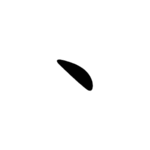Radical 3
| 丶 | ||
|---|---|---|
| ||
| 丶 (U+4E36) "dot" | ||
| Pronunciations | ||
| Pinyin: | zhǔ | |
| Bopomofo: | ㄓㄨˇ | |
| Wade–Giles: | chu3 | |
| Cantonese Yale: | jyú | |
| Jyutping: | zyu2 | |
| Pe̍h-ōe-jī: | tú | |
| Japanese Kana: | チュ chu (on'yomi) てん ten (kun'yomi) | |
| Sino-Korean: | 주 ju | |
| Names | ||
| Chinese name(s): | 點/点 diǎn | |
| Japanese name(s): | 点 ten ちょぼ chobo[1] | |
| Hangul: | 점 jeom | |
| Stroke order animation | ||
 | ||
Radical 3 or radical dot (丶部) meaning "to indicate an end"stroke.
In the radical.
丶 is also the 3rd indexing component in the Table of Indexing Chinese Character Components predominantly adopted by Simplified Chinese dictionaries published in mainland China.
Evolution
-
Bronze script character
-
Small seal script character
Derived characters
| Strokes | Characters |
|---|---|
| +0 | 丶 (zhǔ "dot") |
| +1 | 丷KO (Korean kwukyel note) |
| +2 | 丸SC/JP/丸TC (wán "pellet") |
| +3 | 丹 (dān "vermillion"), 为SC (=爲 -> 爪 / 為 -> 火 wéi "to do, to be; for") |
| +4 | 主 (zhǔ "owner, master; main") 丼 (dǎn onomatopoeia / =井 -> 二 jǐng "water well") |
| +7 | 丽SC (=麗 -> 鹿 lì "pretty, lovely") |
| +8 | 举SC (=舉 -> 臼 jǔ "raise, recommend") |
In calligraphy

The only stroke in Radical 3, known as 點/点 diǎn "dot", is called 側/侧 cè in the eight principles of the character 永 (永字八法 Yǒngzì Bāfǎ) which are the basis of Chinese calligraphy.
References
- ISBN 978-4-469-03163-8.
- ^ Shuowen Jiezi: “丶,有所絶止,丶而識之也。” "Where there is an end, 丶 is used to mark it." This refers to the practice of using 丶 as a judou punctuation mark.
Literature
- Fazzioli, Edoardo (1987). Chinese calligraphy : from pictograph to ideogram : the history of 214 essential Chinese/Japanese characters. calligraphy by Rebecca Hon Ko. New York: ISBN 0-89659-774-1.
- Leyi, Li (1993). Tracing the Roots of Chinese Characters: 500 Cases. Beijing. ISBN 978-7-5619-0204-2.)
{{cite book}}: CS1 maint: location missing publisher (link
External links
Wikimedia Commons has media related to Radical 003.


